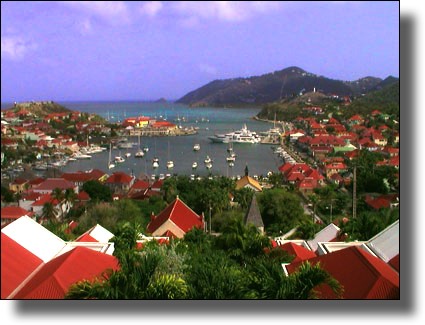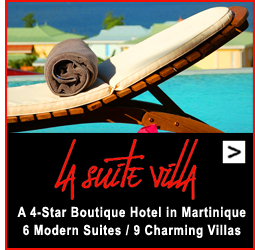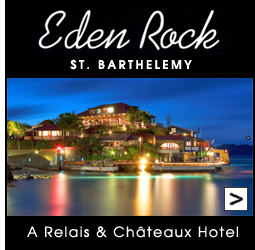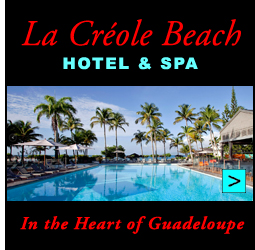St. Barthélemy / St. Barth / St. Barts - Description, Beaches, History
From its postcard harbor to its twenty spectacular beaches, many travelers consider St. Barthélemy (also affectionately known as St. Barts or St. Barth) to be the closest thing to heaven on earth.

Rolling hills, picturesque villages and broad valleys are surrounded by coral reefs, gin-clear waters and blue-green lagoons.
A favorite retreat for the rich and famous, St. Barts is renowned for its natural beauty, delicious cuisine, chic boutiques and relaxed ambiance.
The island lies 208 km (125 mi) northwest of Guadeloupe, and 25 km (15 mi) southeast of St. Martin. Its capitol is Gustavia and the total land area is only about 21 sq km (8 sq mi). The population of St. Barts is nearly 10,000 residents. A few Swedish legacies endure, but many locals are French-speaking descendants of the first Norman, Breton and Poitevin settlers. Tourism has become the primary focus of the island.
St. Barts offers the best that money can buy in the way of peace and quiet, gorgeous scenery, friendly people and fine French cuisine. There are small green mountains, meadows marked with low stone fences, pristine beaches and sandy coves. Gustavia is a charming little village and its harbor, bustling with small boats and luxury yachts, is one of the safest in the Caribbean.
Part of the European Union, St. Barthélemy is an official French Collectivité d’Outre-Mer (COM). It is governed locally by an elected Président and territorial council. Security is provided by policemen and gendarmes.
BEACHES
There are about twenty spectacular beaches on St. Barthélemy (St. Barts, St. Barth), each with its own unique personality. Regardless of where they spend their evenings, most visitors explore a new beach (or two) every day. Few are ever really crowded, even in peak season. All are public and free. There are no designated clothing-optional beaches but nude swimming and sunning are often practiced at Saline and Gouverneur. Toplessness is acceptable and common at pools and beaches.
St. Bart's famous beach of St. Jean includes hotels, restaurants and watersports. Grand Cul-de-Sac on the northeast shore is a haven for windsurfers, with its own hotels and restaurants. To the west, the broad expanse of sand at Flamands, the island's largest beach, also offers a few lodging and dining possibilities.
The little beach at Marigot anchors a deep lagoon that is often one of the best places for snorkeling on the island. The broad expanse at Lorient on the north shore is secluded and favored by island families. Lorient offers calm swimming on its eastern end, and waves for surfing on its western end. Gouverneur on the south shore offers excellent privacy, and the spectacular sands of Saline are popular, but strong winds are often a factor.
Lovely Shell Beach in Gustavia, aptly named since it's composed primarily of small sea shells, is a favorite spot to watch the sunset, and Colombier Beach, secluded and reachable by boat or by a 20-minute hike from Flamands, is worth the effort. Toiny is beautiful but the waves and undertow make it off limits to most swimmers, although it's popular with surfers. The same is true of nearby Washing Machine Beach at Grand Fond.
A BRIEF HISTORY
The historical significance of St. Barthélemy (St. Barts, St. Barth) is far out of proportion to its tiny size. Discovered by Columbus in 1493 and named for his brother Bartolomeo, it was settled around 1648 by French colonists who were living on the nearby island of St. Kitts. This early settlement did not prosper and in 1651 the island was sold to the Knights of Malta.
Five years later it was raided by the fierce Carib Indians, then abandoned until 1673, when it was again settled by Frenchmen from Normandy and Brittany. This time the colony was successful and the source of much of that prosperity was French buccaneers who swarmed to the island, bringing with them vast quantities of plunder taken from Spanish galleons. Monbars the Exterminator, a famous buccaneer, reputedly maintained headquarters in St. Barthélemy and his treasure is believed to still be hidden somewhere between Anse du Gouverneur and Grande Saline.
Many of the people of St. Barthélemy were tradesmen and shopkeepers, while others maintained farms. The farms were generally of a modest size, and the topography and climate never were not appropriate to create a sugar economy. Except for a brief takeover by the British in 1758, St. Barthélemy remained French until 1784 when it was sold suddenly to Sweden by one of Louis XVI's ministers in exchange for trading rights.
While the permanent population continued to till the soil, the Swedes took over, renamed the harbor Gustavia in honor of their King, declared it a neutral free port, and made fortunes in trade. When Europe's wars subsided, France repurchased the island in 1878, but this time there was no more trading with warring nations and little agriculture to speak of. The free port status remained, and still does, along with such Swedish mementos as bits of architecture, a few street signs, and, of course, the name of its capital, Gustavia.
A favorite retreat for the rich and famous, St. Barts is renowned for its natural beauty, delicious cuisine, chic boutiques and relaxed ambiance.
The island lies 208 km (125 mi) northwest of Guadeloupe, and 25 km (15 mi) southeast of St. Martin. Its capitol is Gustavia and the total land area is only about 21 sq km (8 sq mi). The population of St. Barts is nearly 10,000 residents. A few Swedish legacies endure, but many locals are French-speaking descendants of the first Norman, Breton and Poitevin settlers. Tourism has become the primary focus of the island.
St. Barts offers the best that money can buy in the way of peace and quiet, gorgeous scenery, friendly people and fine French cuisine. There are small green mountains, meadows marked with low stone fences, pristine beaches and sandy coves. Gustavia is a charming little village and its harbor, bustling with small boats and luxury yachts, is one of the safest in the Caribbean.
Part of the European Union, St. Barthélemy is an official French Collectivité d’Outre-Mer (COM). It is governed locally by an elected Président and territorial council. Security is provided by policemen and gendarmes.
BEACHES
There are about twenty spectacular beaches on St. Barthélemy (St. Barts, St. Barth), each with its own unique personality. Regardless of where they spend their evenings, most visitors explore a new beach (or two) every day. Few are ever really crowded, even in peak season. All are public and free. There are no designated clothing-optional beaches but nude swimming and sunning are often practiced at Saline and Gouverneur. Toplessness is acceptable and common at pools and beaches.
St. Bart's famous beach of St. Jean includes hotels, restaurants and watersports. Grand Cul-de-Sac on the northeast shore is a haven for windsurfers, with its own hotels and restaurants. To the west, the broad expanse of sand at Flamands, the island's largest beach, also offers a few lodging and dining possibilities.
The little beach at Marigot anchors a deep lagoon that is often one of the best places for snorkeling on the island. The broad expanse at Lorient on the north shore is secluded and favored by island families. Lorient offers calm swimming on its eastern end, and waves for surfing on its western end. Gouverneur on the south shore offers excellent privacy, and the spectacular sands of Saline are popular, but strong winds are often a factor.
Lovely Shell Beach in Gustavia, aptly named since it's composed primarily of small sea shells, is a favorite spot to watch the sunset, and Colombier Beach, secluded and reachable by boat or by a 20-minute hike from Flamands, is worth the effort. Toiny is beautiful but the waves and undertow make it off limits to most swimmers, although it's popular with surfers. The same is true of nearby Washing Machine Beach at Grand Fond.
A BRIEF HISTORY
The historical significance of St. Barthélemy (St. Barts, St. Barth) is far out of proportion to its tiny size. Discovered by Columbus in 1493 and named for his brother Bartolomeo, it was settled around 1648 by French colonists who were living on the nearby island of St. Kitts. This early settlement did not prosper and in 1651 the island was sold to the Knights of Malta.
Five years later it was raided by the fierce Carib Indians, then abandoned until 1673, when it was again settled by Frenchmen from Normandy and Brittany. This time the colony was successful and the source of much of that prosperity was French buccaneers who swarmed to the island, bringing with them vast quantities of plunder taken from Spanish galleons. Monbars the Exterminator, a famous buccaneer, reputedly maintained headquarters in St. Barthélemy and his treasure is believed to still be hidden somewhere between Anse du Gouverneur and Grande Saline.
Many of the people of St. Barthélemy were tradesmen and shopkeepers, while others maintained farms. The farms were generally of a modest size, and the topography and climate never were not appropriate to create a sugar economy. Except for a brief takeover by the British in 1758, St. Barthélemy remained French until 1784 when it was sold suddenly to Sweden by one of Louis XVI's ministers in exchange for trading rights.
While the permanent population continued to till the soil, the Swedes took over, renamed the harbor Gustavia in honor of their King, declared it a neutral free port, and made fortunes in trade. When Europe's wars subsided, France repurchased the island in 1878, but this time there was no more trading with warring nations and little agriculture to speak of. The free port status remained, and still does, along with such Swedish mementos as bits of architecture, a few street signs, and, of course, the name of its capital, Gustavia.

Rolling hills, picturesque villages and broad valleys are surrounded by coral reefs, gin-clear waters and blue-green lagoons.
A favorite retreat for the rich and famous, St. Barts is renowned for its natural beauty, delicious cuisine, chic boutiques and relaxed ambiance.
The island lies 208 km (125 mi) northwest of Guadeloupe, and 25 km (15 mi) southeast of St. Martin. Its capitol is Gustavia and the total land area is only about 21 sq km (8 sq mi). The population of St. Barts is nearly 10,000 residents. A few Swedish legacies endure, but many locals are French-speaking descendants of the first Norman, Breton and Poitevin settlers. Tourism has become the primary focus of the island.
St. Barts offers the best that money can buy in the way of peace and quiet, gorgeous scenery, friendly people and fine French cuisine. There are small green mountains, meadows marked with low stone fences, pristine beaches and sandy coves. Gustavia is a charming little village and its harbor, bustling with small boats and luxury yachts, is one of the safest in the Caribbean.
Part of the European Union, St. Barthélemy is an official French Collectivité d’Outre-Mer (COM). It is governed locally by an elected Président and territorial council. Security is provided by policemen and gendarmes.
BEACHES
There are about twenty spectacular beaches on St. Barthélemy (St. Barts, St. Barth), each with its own unique personality. Regardless of where they spend their evenings, most visitors explore a new beach (or two) every day. Few are ever really crowded, even in peak season. All are public and free. There are no designated clothing-optional beaches but nude swimming and sunning are often practiced at Saline and Gouverneur. Toplessness is acceptable and common at pools and beaches.
St. Bart's famous beach of St. Jean includes hotels, restaurants and watersports. Grand Cul-de-Sac on the northeast shore is a haven for windsurfers, with its own hotels and restaurants. To the west, the broad expanse of sand at Flamands, the island's largest beach, also offers a few lodging and dining possibilities.
The little beach at Marigot anchors a deep lagoon that is often one of the best places for snorkeling on the island. The broad expanse at Lorient on the north shore is secluded and favored by island families. Lorient offers calm swimming on its eastern end, and waves for surfing on its western end. Gouverneur on the south shore offers excellent privacy, and the spectacular sands of Saline are popular, but strong winds are often a factor.
Lovely Shell Beach in Gustavia, aptly named since it's composed primarily of small sea shells, is a favorite spot to watch the sunset, and Colombier Beach, secluded and reachable by boat or by a 20-minute hike from Flamands, is worth the effort. Toiny is beautiful but the waves and undertow make it off limits to most swimmers, although it's popular with surfers. The same is true of nearby Washing Machine Beach at Grand Fond.
A BRIEF HISTORY
The historical significance of St. Barthélemy (St. Barts, St. Barth) is far out of proportion to its tiny size. Discovered by Columbus in 1493 and named for his brother Bartolomeo, it was settled around 1648 by French colonists who were living on the nearby island of St. Kitts. This early settlement did not prosper and in 1651 the island was sold to the Knights of Malta.
Five years later it was raided by the fierce Carib Indians, then abandoned until 1673, when it was again settled by Frenchmen from Normandy and Brittany. This time the colony was successful and the source of much of that prosperity was French buccaneers who swarmed to the island, bringing with them vast quantities of plunder taken from Spanish galleons. Monbars the Exterminator, a famous buccaneer, reputedly maintained headquarters in St. Barthélemy and his treasure is believed to still be hidden somewhere between Anse du Gouverneur and Grande Saline.
Many of the people of St. Barthélemy were tradesmen and shopkeepers, while others maintained farms. The farms were generally of a modest size, and the topography and climate never were not appropriate to create a sugar economy. Except for a brief takeover by the British in 1758, St. Barthélemy remained French until 1784 when it was sold suddenly to Sweden by one of Louis XVI's ministers in exchange for trading rights.
While the permanent population continued to till the soil, the Swedes took over, renamed the harbor Gustavia in honor of their King, declared it a neutral free port, and made fortunes in trade. When Europe's wars subsided, France repurchased the island in 1878, but this time there was no more trading with warring nations and little agriculture to speak of. The free port status remained, and still does, along with such Swedish mementos as bits of architecture, a few street signs, and, of course, the name of its capital, Gustavia.
________________________________________
French Caribbean International has been the premier guide to the French West Indies since 1994. We provide a wealth of helpful travel information for visitors to the Caribbean islands of St. Barthélemy (St. Barts, St. Barth, St. Barths), St. Martin / St. Maarten, Martinique, Guadeloupe, Les Saintes and Marie-Galante.







